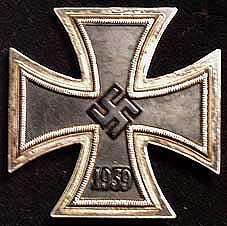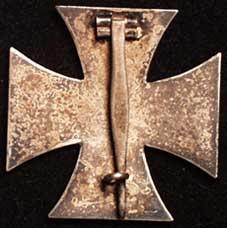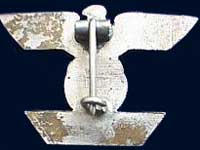|
|
Introduction
The Iron Cross 1st Class was presented considerable more sparingly than the 2nd Class, and therefore held more prestige. Unlike previous versions of the 1st Class, it was highly standardized and like the 2nd Class 1939, all imperial symbols were removed.
Manufacturing and Technical Information
The Iron Cross 1st Class had the same dimensions (measuring 44mm by 44mm) and identical obverse features as the 2nd Class. The reverse was a solid silvered metal piece, however, with only the “fat bellied” pin and hook. The solid iron core fitted between the back piece and the front frame. The manufacturers mark, if any, was stamped on the pin or on the lower arm of the Cross. The Cross was finished in mat or semi-mat black and the quality of the pieces manufactured was again exceptional.
A privately purchase variation that is often encountered is the “screwback” type that was considerably more secured and preferred by combat troops. Instead of a pin, these Crosses had a protruding threaded tube that was placed through the tunic and held by a round plate and that screwed on from behind. A small pin on the reverse of the upper arm kept the Cross from rotating on its axis. There were also Crosses not made from solid iron for wear by Kriegsmarine, and initially some manufacturers produced convex Crosses which were popular in World War I, but this practice was officially discontinued by May 1941.
Presentation, Wear and Documents
The Cross was presented in a black leathered box with an imprint of the Iron Cross in silver on the lid. The lining on the inside lid was white satin and the base was velvet, with an impression where the award fit. As with the 2nd Class, a standard award document and the proper Solbuch signatures and stamps accompanied the Cross

|
The Iron Cross 1st Class was worn on the left breast pocket of the tunic at all times. Because of this, most recipients purchased an official copy of the award to keep the original safe. When this was done, many preferred the screwback variation described above.
Award Criteria
In order to receive the Iron Cross 1st Class Heer and Waffen SS men would have to perform three to four further acts of courage from the one that earned him the 2nd Class. It was regularly awarded to U-boat Commander upon sinking 50,000 tons and to Lufftwaffe pilots when they achieved six or seven confirmed kills. Of course these were only guidelines, and a single act of great importance or a long steady career could earn that person the Cross.
The Iron Cross 1st Class was held in high esteem, and between 300,000 and 575,000 Iron Cross 1st Class were awarded during World War II.

|
Obverse |  |
Reverse |
|---|
1939 Spange to the 1914 Iron Cross 1st Class
The Bar to the Iron Cross 1st Class was very similar to its 2nd Class cousin, but with a slightly larger wingspan on the Eagle (44mm). It was worn directly above the 1914 Iron Cross 1st Class and a wide tapering clip held it. Some recipients chose to solder the bar onto the 1914 Cross and there were several hook styles, including the “screwback” type. It was presented either in an envelope with the title of the award printed in gothic lettering or in a box similar to that of the Iron Cross. The Bar suffered from the some decline in manufacturing materials later in the war, but the quality of details remained high.

|
Obverse |  |
Reverse |
|---|
Iron Cross 1st Class 1957
The Iron Cross 1st Class 1957 had the same characteristics as the other 1957 Iron Cross grades in that an Oak Leave spray replaced the Swastika as the center ornament of the award. Other than this, it retained all other characteristics as its predecessor in 1939. The new crosses were only manufactured in the pin-back version, as most soldiers who earned the Cross and were still in service with the new German Army preferred to wear the award on the ribbon bar, a practice which was authorized in the Bundeswehr. It was manufactured in three pieces with the rim made of “stay bright” alloy. As with most other 1957 awards the quality, when compared to the previous release, was inferior.
1957 Spange to the 1914 Iron Cross 1st Class

|
|
1957 Spange to the
Iron Cross 1st Class 1914 |
The Spange for the Iron Cross 1914 was complete redesigned and bears no resemblance to the 1939 edition. The Spange was exactly the same as the 2nd Class, a rectangular bar with the year “1939” and an Iron Cross 1957 in the center, but instead of the two prongs it had a thin pin and catch that facilitated attachment to the inform. It measured 30mm across, with the Cross measuring 14x14mm and the bar bearing the year measuring 7mm in height. The Spange was manufactured in “stay bright” alloy and black paint was applied to the center Cross. The craftsmanship was good but not remarkable.
| Iron Cross Index | Iron Cross Recipients Index |
| Main Page | Iron Cross | German Cross | War Merit Cross | Wound Badges | War Badges |
| Campaign Awards | Service Awards | Axis Allies | Collectors Corner | Online Forum | Bibliography |